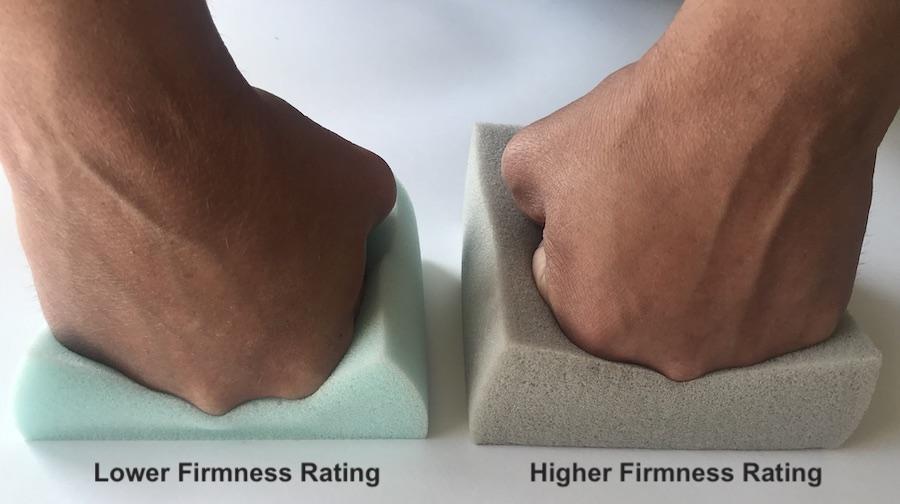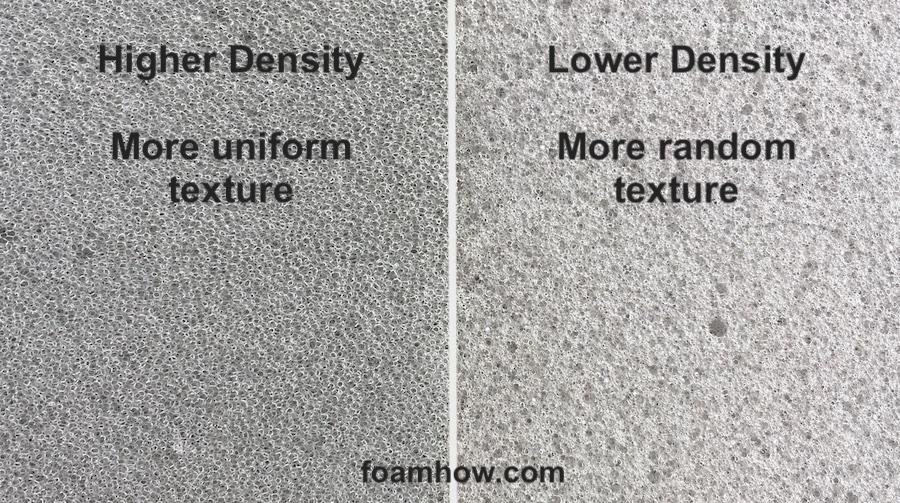If you’re going to start an important project or multiple projects using foam, there are some fundamentals you ideally need to understand. Foam density and firmness are important aspects of the foam you choose.
Having spent time in the upholstery business I’ve come to know enough about foam and have set about trying to help people understand it with greater ease when selecting foam for their own project. So, in this article, I’m going to explain what foam density and firmness are.
Density and firmness are two separate measurements of foam strength and quality. Firmness is how soft the foam is, rated on a scale between 10 and 60 or more. Whereas density denotes the weight of the foam – usually between 1lb and 3lb in weight but can go up to 15lb. Density is an indicator of quality and longevity.
When selecting foam, aspects such as outdoor or indoor foam, the proper use, and fire retardancy regulations are important. But to choose the right foam for the right task you need to understand more about the numbers. And often these numbers are what you rarely see or get told.
Suppliers vary in their type and style of labeling of foam, and to a large extent, it’s simplified with simple words like soft and firm.
But the numbers related to foam density and firmness are the two numbers that are important to know, so always ask for the numbers. Here’s an example of what the numbers will look like, then we’ll get into some details about each.

Difference between foam density and firmness
They might sound the same, but density and firmness are two different aspects of foam, and both are measured in different ways.
In simple terms, firmness is a measure of how soft the foam is, how likely you are to “sink” into it. Whereas, density is a measure of how heavy (or dense) the foam is.
Foam firmness
Foam firmness is a technical measurement indicating how easily a foam will compress. Lower firmness offers a more plush or “sinking” effect when pressure is applied. Wheras a firmer foam will not “give” as much and remain stiffer under pressure. Firmness ranges between 10 and 60, sometimes more.
The technical expression of firmness is Indentation Load Deflection (ILD). Also known as Indentation Force Deflection (IFD)
How do you calculate ILD?
ILD (Indentation Load Deflection), is a measure of the softness or firmness of a given piece of foam. ILD is measured by applying downward pressure from a 12-inch round disk into a 4-inch piece of foam. Pressure is slowly applied until the foam compresses to 25% or one inch into its surface.
This technical test produces a figure determining the number of pounds it takes to compress a certain area of foam by 25% of its thickness. This is a standardized test to compare all foam types on a level playing field.
So a 4” sample requires a certain amount of pressure to reduce to 3” in thickness (25%). The amount of pressure required to achieve this provides the numeric 2 digit value of firmness usually ranging from 10 to 60, but could be higher. You can compare the firmness of most types of foam here.
Foam firmness example 1:
A 6-inch seat cushion will probably need an ILD of about 30 to 35 in order to be “firm” enough for the average person to be comfortable. For a sofa back, you would only require something around a 20 ILD to provide sufficient support.
Foam firmness example 2:
A dining chair with a 1-inch seat cushion will require a higher firmness, so an ILD of 45 to 60 is probably needed to prevent feeling the chair platform under the foam.
Firmness is relative
There are other factors that come into play regarding foam firmness. One of which is the amount of weight and comfort required.
A child is less likely to sink into foam than a heavy person. So knowing “who” is going to be using the foam becomes a factor.
Also, how are you using the item of furniture? If you’re lying down then weight distribution is wider, requiring less firmness. Sitting upright in a chair would require greater firmness. When sitting down or lying down, the foam will feel like a different firmness for each.
In scenarios where foam has a dual purpose, perhaps a fold-out sofa bed, for example, becomes more difficult to cater for.
To make the consumer world of foam easier to understand, we simplify the numeric values into generic terms that we apply to foam firmness, based on the results of the technical test. Here’s an idea of how the numbers relate to different foam firmness descriptions…
| Firmness (ILD) | Number code | Common Description |
|---|---|---|
| 1.0 – 1.7 lb | 10 – 27 | Plush to super-plush |
| 1.8 – 2.3 lb | 18 – 23 | Soft |
| 2.4 – 3.0 lb | 24 – 30 | Medium |
| 3.0 – 3.4 lb | 30 – 34 | Firm |
| 3.4 – 4.4 lb | 34 – 44 | Extra firm |
| 4.4 – 6.0 lb | 44 – 60 | Super firm |
| 60+ | 60 or higher | Supreme |
How to gauge the firmness of a foam
If you don’t have, or can’t get the exact four digit numbers for a foam product. Then there is a rudimentary way of gauging the firmness.
You can usually see firmness in action yourself simply by lying on a few different beds in the bed store. And you don’t need a machine to test it for yourself – just to get a rough idea.
In the image below, I’m applying roughly the same pressure to two different types of foam. As you can see the one on the right is more resistant to my downward pressure. So I can safely assume that this has a higher firmness rating than the one on the left.

If you’re considering buying foam and can see it first hand, or can obtain a sample beforehand, then apply this simple test yourself and you will get a better understanding of what the firmness rating actually means.
So now we know that foam density and firmness are not the same things, and we now know what foam firmness is, let’s move on to foam Density
Foam Density
Foam density simply relates to how heavy the foam is. Foam density is a unit of measurement that demonstrates how much weight foam can support per cubic foot. The two numbers are then combined. so 2.8lb equates 28. Density is also an indication of durability. The higher the number, the greater longevity.
The denser (heavier) the foam is, the more tightly packed the membrane is, meaning more product is present per cubic foot, and therefore it has greater resilience and longevity.
Again, how you use the foam comes into play. A higher density foam should be used in higher traffic areas.
Density is not a measure of how firm the foam will be. Foam can, in fact, be soft to press down, but dense in weight (or quality). Density is mainly an indicator of the quality and lifespan of the foam.
Density for upholstery foam will range from about 1.X lb to 3.X lb, but some foams such as recon foam can be as high as 6.0 lb or more.
High density is not to be confused with high resilience – which I’ve explained here.
How to gauge the density of a foam
You don’t necessarily need machinery to tell you. In fact, you probably won’t have access to a machine to get any accurate readings. But to get an idea of density when comparing different foams, simply hold a section of the foam in your hand (or hands) and feel the weight. Do this for another foam and you may get a sense of which is heavier.
Also, look closely at the product. As you can see in the image below, often a high density next to a low density becomes more obvious as higher density is far more uniform with fiber than a foam that is of low density.

Greater density costs more
A higher density usually costs more because there is more “product” involved. And the life of the foam is expected to be longer.
You should consider density along with cost when considering the application. A chair in a guest room will likely not be used much and could therefore have a lower density. Perhaps 20 – 35 density.
A sofa in a busy family room will likely see high usage and should require a higher density. Something in the region of 35 – 45 or more.
Here’s a Youtube video that echoes what I’ve explained about foam density and firmness.
What is the most dense foam?
The densest foam is arguably chip foam. Also called recon, or rebond foam. It has a density rating between 6 lb – 15 lb per square foot (60-150). As opposed to most foams which range between around 1.0 lb and 3.6 lb density per square foot. It has a high firmness rating too, so it has less “give”
Is high-density foam comfortable?
High-density foam is comfortable for the right person. It will be heavy so it will last longer. However, if you do not like to “sink” into the cushion you are sitting on, or have problems moving in a bed with lots of “give” should look for a foam with a higher firmness rating more than density.
To help further
I hope this has provided some insight into foam density and firmness. For help in choosing the right foam, be sure to check my article on the types of foam.
